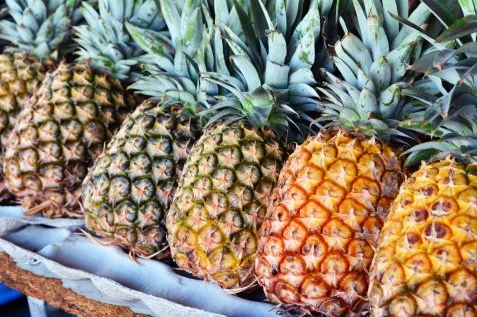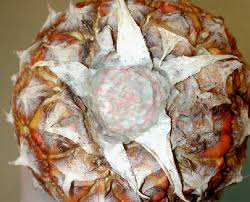Mold On Bottom Of Pineapple – Causes, Safety, and Prevention!
Mold on the pineapple bottom appears due to moisture, sugar, and poor storage. It’s unsafe to eat, so always check spoilage signs, store properly, and prevent fungal growth with simple storage tips.
One of the most popular tropical fruits is the pineapple. It is juicy, sweet, and refreshing. But many people face a common problem when storing or buying pineapples mold on the bottom of pineapple. This usually shows up as white mold on pineapple or sometimes even black mold on pineapple.
If you have ever wondered why this happens, whether the fruit is safe to eat, or how to prevent it, this guide will help. We’ll explain everything in simple words so you can easily understand.
Why Does Mold Grow on Pineapples?
Mold is a type of fungus that grows on food when conditions are right, especially when there is moisture, warmth, and natural sugar. Pineapple has all three, which makes it more likely to spoil quickly. The bottom of the pineapple is where most of the juice and sugar settle. This part is softer and sweeter than the top. Because of that, mold starts forming there first.
Here are the main reasons:
- Natural sugars and mold growth Pineapple has a lot of sugar, which attracts mold.
- Moisture at the base If the bottom stays wet, it creates a perfect place for mold.
- Poor storage Leaving pineapple in warm or humid areas speeds up spoilage.
- Bruises or damage If the fruit skin is damaged, it becomes easier for fungal growth on pineapple.
How to Tell If a Pineapple Is Bad?

Sometimes it’s hard to know if a pineapple is still good to eat. Here are simple pineapple spoilage signs you should look for:
- White or green fuzzy spots (mold).
- Pineapple skin turning white or black.
- A sour, alcoholic, or fermented smell.
- The fruit feels soft and mushy, especially at the bottom.
- Leaking juice or sticky liquid.
If you notice one or more of these, your pineapple is going bad.
Is Mold on Pineapple Safe to Eat?
One of the biggest questions people ask is: “Can you eat pineapple with mold?”
The answer is: No, it is not safe.
Here’s why:
- Mold produces mycotoxins that can make you sick.
- Even if only the bottom has mold, the spores may have spread inside the fruit.
- Eating moldy pineapple may cause stomach problems, allergies, or food poisoning.
So, if you see mold, it’s better to throw the fruit away.
Can You Cut Off the Moldy Part and Eat the Rest?
Some foods, like hard cheese or carrots, can be saved by cutting mold off fruit or vegetables. But pineapple is different. The flesh of pineapple is soft and porous, which means mold can travel inside without being visible. Cutting away the moldy part may not remove all the dangerous spores.
👉 If only a tiny spot on the skin is moldy and the inside looks firm, you may try trimming it very deeply (at least 1–2 inches). But for fruit mold safety, it is usually best to discard the whole fruit.
Health Risks of Eating Moldy Pineapple
Eating moldy pineapple can cause health issues, especially if you are sensitive. Some possible risks include:
- Nausea, vomiting, or diarrhea (food poisoning symptoms).
- Allergic reactions, such as sneezing or skin irritation.
- Breathing problems in people with asthma or mold allergies.
- Harmful effects from mycotoxins in certain types of mold.
Those with weakened immunity systems, children, and the elderly are more at risk.
How to Store Pineapple Correctly (and Prevent Mold)?
Good storage is the key to keeping your pineapple fresh. Here are some pineapple storage tips:
- Whole pineapple
- At room temperature: lasts 2–3 days.
- In the fridge: lasts up to 5–7 days.
- At room temperature: lasts 2–3 days.
- Cut pineapple
- Keep in your fridge in an airtight container.
- It will stay good for 3–4 days.
- Adding a little lemon juice can help prevent mold.
- Keep in your fridge in an airtight container.
- Keep it dry
- Avoid washing the pineapple until you are ready to cut it.
- Extra moisture encourages mold.
- Avoid washing the pineapple until you are ready to cut it.
- Refrigeration and pineapple storage
- Always store it in the fridge if you are not eating it right away.
- Always store it in the fridge if you are not eating it right away.
Why Does Pineapple Mold Faster Than Other Fruits?

Pineapples spoil faster than many other fruits because:
- They contain high natural sugar, which feeds mold.
- They ripen quickly after harvesting.
- Their skin can hide small cuts or bruises where mold enters.
- The pineapple ripening process continues even after picking.
This is why the fresh pineapple shelf life is shorter compared to apples, oranges, or melons.
How to Prevent Pineapple Mold in the Future?
You can take simple steps to keep pineapples fresh longer and prevent mold:
- Choose pineapples with firm skin and no wet or dark spots.
- Store upside down for a few hours this spreads juice evenly and reduces mold at the bottom.
- Keep away from bananas or apples, which release gas that speeds up ripening.
- Wash the outer skin with vinegar and water before cutting to reduce surface mold spores.
These simple tricks will help you enjoy your pineapple longer.
FAQs:
1. What causes mold on the bottom of pineapples?
Mold forms on pineapple bottoms because that part holds the most sugar and moisture. Combined with warmth or poor storage, it creates the perfect place for fungal growth, leading to visible mold.
2. Can washing the skin prevent mold growth?
Yes, rinsing pineapple with a mild vinegar water solution before cutting can reduce surface mold spores. While it doesn’t stop internal spoilage, it helps delay mold growth and keeps the fruit fresh longer.
3. Why does pineapple spoil faster than apples or oranges?
Pineapples spoil quicker because they’re high in sugar, continue ripening after harvest, and bruise easily. Unlike apples or oranges, their porous texture allows mold and bacteria to spread faster inside the fruit.
4. Is it safe to eat slightly moldy pineapple after trimming?
No, it’s not safe. Pineapple flesh is soft and porous, which lets mold spread invisibly inside. Even after trimming the visible mold, spores and toxins may remain, making the fruit unsafe for eating.
5. How can I extend pineapple shelf life at home?
To extend pineapple shelf life, refrigerate immediately, store cut pieces in airtight containers, and keep the fruit dry. Storing it upside down helps redistribute juices, reducing bottom mold, and slowing the spoiling process.
Conclusion
Mold on the bottom of pineapple is a common problem caused by sugar, moisture, and improper storage. Eating moldy pineapple is unsafe, as it may spread toxins and cause health risks. Instead, learn to recognize spoilage signs, follow proper storage methods, and use prevention tips like refrigeration, dryness, and washing the skin. By caring for your pineapples properly, you can enjoy their natural sweetness without worrying about mold, food safety issues, or wasting fruit. Fresh storage equals safe eating.






